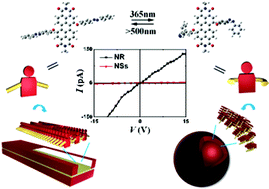Light-controlled self-assembly and conductance: from nanoribbons to nanospheres†
Abstract
Photoswitchable

* Corresponding authors
a
State Key Laboratory of Crystal Materials, Shandong University, Jinan, P. R. China
E-mail:
txt@icm.sdu.edu.cn
Tel: +86-531-88364963
b
Key laboratory of Colloid and Interface Chemistry, Ministry of Education, School of Chemistry and Chemical Engineering, Shandong University, Jinan, P. R. China
E-mail:
sunxuan@sdu.edu.cn
Tel: +86-531-88362326
c School of Chemistry and Chemical Engineering, Shandong University, Jinan, P. R. China
d Shanghai Institute of Applied Physic, Chinese Academy of Science, Shanghai, P. R. China
Photoswitchable

 Please wait while we load your content...
Something went wrong. Try again?
Please wait while we load your content...
Something went wrong. Try again?
L. Ma, J. Jia, T. Yang, G. Yin, Y. Liu, X. Sun and X. Tao, RSC Adv., 2012, 2, 2902 DOI: 10.1039/C2RA00816E
To request permission to reproduce material from this article, please go to the Copyright Clearance Center request page.
If you are an author contributing to an RSC publication, you do not need to request permission provided correct acknowledgement is given.
If you are the author of this article, you do not need to request permission to reproduce figures and diagrams provided correct acknowledgement is given. If you want to reproduce the whole article in a third-party publication (excluding your thesis/dissertation for which permission is not required) please go to the Copyright Clearance Center request page.
Read more about how to correctly acknowledge RSC content.
 Fetching data from CrossRef.
Fetching data from CrossRef.
This may take some time to load.
Loading related content
